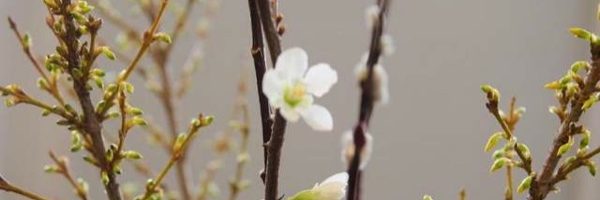Thanks to Horticultural Chair, Carol Giunta, for this information:
Cutting basics:
- When cutting branches for forcing blooms, if possible, try to prune on a day that’s above freezing. It is easier for the plant to heal, plus the branch will transition faster to the indoor temperature.
- Always consider a plant’s overall appearance before removing branches. Select branches that will not impact the plant’s desired shape. Choose branches from the denser parts of the plant to minimize the effect on the spring bloom display. Consider cutting crossing branches, since they need to be pruned to reduce damage from disease and insects.
- Use sound pruning techniques to make cuts:
- Use clean, sharp pruners
- Make smooth cuts. Jagged areas can catch disease
- Do not cut on an angle that will collect water
- Do not leave a stub
- Choose branches less that ½” in diameter
- Choose branches with the plumpest buds. Narrow buds are more typical for leaves, not flowers.
- Cut branches at least 12” long. Cut more branches than you think you’ll need.
Forcing basics:
- Place branches in a container of warm water, then, while stems are still underwater, make a fresh cut 1” from the base.
- Remove any buds, twigs, or leaves that will be under water in the vase.
- Fill container with no more than 3” of tepid (100 °) water; add floral preservative, if desired. Let branches sit in warm water for about 30 minutes, then fill container with cool water.
- Keep container in a partially shaded area, away from heaters. Once the buds begin to open, move the container to an area with bright, indirect light.
- Change the water/floral preservative weekly.
Flower show basics:
- All horticulture must be fresh plant material grown by the exhibitor.
- All specimens must be submitted with Latin name, giving genus and species. Common name may be added. Exhibitor may enter more than one entry per class or sub-class, if each is different. (i.e. color). Classes may be subdivided by color, type or cultivar on the day of the show, if necessary. Please email cagiunta@sbcglobal.net if you are unsure of the plant’s complete Latin name.
- All plants must have been in exhibitor’s possession at least 90 days.
- Clear containers will be used for cut specimens, provided by exhibitor.
- All entries must be well groomed.
- The Classification Chair must pass all entries.
- Cut specimens should not have foliage below the water line.
- Advanced entries must be sent to Carol Giunta 7 Hollow Spring Rd, Norwalk, CT 06854, 203 855-9740, cagiunta@sbcglobal.net, by February 22, 2016.
More information:
https://hort.purdue.edu/ext/HO-23.pdf
http://my.chicagobotanic.org/horticulture/how-to/forcing-branches/
http://www.finegardening.com/forcing-branches
http://www.bhg.com/gardening/trees-shrubs-vines/care/forcing-branches-into-bloom/
http://www.almanac.com/content/forcing-branches-bloom-indoors


